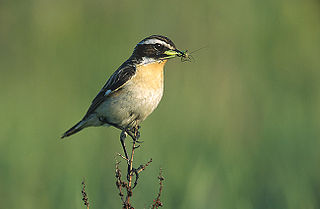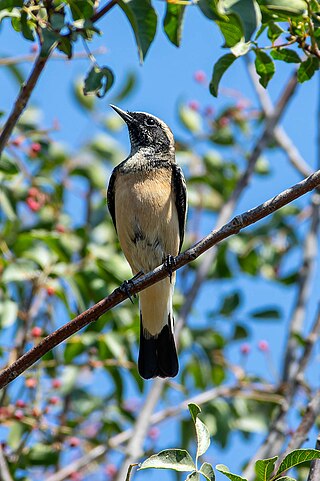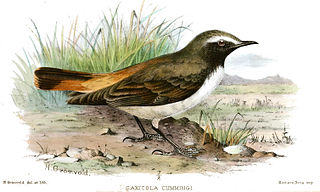
Chats are a group of small Old World insectivorous birds formerly classified as members of the thrush family (Turdidae), but following genetic DNA analysis, are now considered to belong to the Old World flycatcher family (Muscicapidae).

The wheatears are passerine birds of the genus Oenanthe. They were formerly considered to be members of the thrush family, Turdidae, but are now more commonly placed in the flycatcher family, Muscicapidae. This is an Old World group, but the northern wheatear has established a foothold in eastern Canada and Greenland and in western Canada and Alaska.

The isabelline wheatear is a small passerine bird that was formerly classed as a member of the thrush family Turdidae, but is now more generally considered to be an Old World flycatcher in the family Muscicapidae. It is a migratory insectivorous bird. Its habitat is steppe and open countryside and it breeds in southern Russia and Central Asia to northern Pakistan, wintering in Africa and northwestern India. It is a very rare vagrant to western Europe.

The western black-eared wheatear is a wheatear, a small migratory passerine bird that was formerly classed as a member of the thrush family Turdidae, but is now considered to be an Old World flycatcher. It was formerly considered conspecific with the eastern black-eared wheatear.

The Cyprus wheatear or Cyprus pied wheatear is a small, 14–15 cm long passerine bird that was formerly classed as a member of the thrush family Turdidae, but is now more generally considered to be an Old World flycatcher, Muscicapidae. It was formerly treated as a subspecies (race) of pied wheatear but Sluys and van den Berg (1982) argued that the form deserved full species status, on the basis of differences in biometrics and especially song, and the lack of sexual plumage dimorphism in cypriaca.

The northern wheatear or wheatear is a small passerine bird that was formerly classed as a member of the thrush family Turdidae, but is now more generally considered to be an Old World flycatcher, Muscicapidae. It is the most widespread member of the wheatear genus Oenanthe in Europe and North and Central Asia.

The white-crowned wheatear, or white-crowned black wheatear is a wheatear, a small passerine bird that was formerly classed as a member of the thrush family Turdidae, but is now more generally considered to be an Old World flycatcher, Muscicapidae.

The black wheatear is a wheatear, a small passerine bird in the Old World flycatcher family Muscicapidae. It is found in southern Spain and western North Africa.

The hooded wheatear is a wheatear, a small insectivorous passerine that was formerly classed as a member of the thrush family Turdidae, but is now more generally considered to be an Old World flycatcher, Muscicapidae.

The capped wheatear is a small insectivorous passerine bird that is widely distributed over southern Africa. It was formerly classed as a member of the thrush family Turdidae, but is now placed in the Old World flycatcher family, Muscicapidae.

Hume's wheatear is a species of bird in the Old World flycatcher family Muscicapidae. This black-and-white bird is found in southern Afghanistan, Iran, extreme northeast Iraq, Oman, Pakistan, Qatar and the United Arab Emirates.

The buff-breasted wheatear is a species of bird in the Old World flycatcher family Muscicapidae that is found in the montane areas of the southwestern Arabian Peninsula. It is also known as Botta's wheatear or the red-breasted wheatear. The species is named after Paul-Émile Botta.

The mourning wheatear is a bird, one of 14 species of wheatear found in northern Africa and the Middle East. It is a small passerine in a group formerly classed as members of the thrush family Turdidae, but now more generally considered to be part of the Old World flycatcher family Muscicapidae.

The Kurdish wheatear, also known as the Kurdistan wheatear, the chestnut-rumped wheatear or the red-rumped wheatear, is a species of bird in the family Muscicapidae. The red-tailed wheatear was formerly considered a subspecies of this bird but is now often regarded as a separate species. The two may intergrade in Iran but it is also possible that the rather differently coloured cummingi is in fact a one-year-old O. xanthoprymna with intermediate plumage.

The red-tailed wheatear, also known as the rusty-tailed wheatear, Persian wheatear or Afghan wheatear, is a small passerine bird breeding in mountainous areas of south-west and central Asia. It belongs to the wheatear genus Oenanthe which was formerly placed in the thrush family Turdidae but is now in the Old World flycatcher family Muscicapidae. The red-tailed wheatear used to be considered a subspecies of the Kurdish wheatear but is now often regarded as a separate species.

The Abyssinian wheatear, or Abyssinian black wheatear, is a species of bird in the family Muscicapidae, the Old World flycatchers and chats. It is found from Ethiopia to southern Kenya and north-eastern Tanzania.

The eastern black-eared wheatear is a wheatear, a small migratory passerine bird that was formerly classed as a member of the thrush family Turdidae, but is now considered to be an Old World flycatcher. It was formerly considered conspecific with the western black-eared wheatear.

The Atlas wheatear, also known as the black-throated wheatear or Seebohm's wheatear, is a small passerine bird which breeds in the Maghreb region of North Africa and winters in the western Sahel. It was formerly considered a subspecies of the northern wheatear as O. o. seebohmi, but was reclassified as a distinct species by the IOC in 2021.

The Maghreb wheatear is a bird, a species of wheatear found in northern Africa. It is a small passerine in a group formerly classed as members of the thrush family Turdidae, but now more generally considered to be part of the Old World flycatcher family Muscicapidae.

The rusty-breasted wheatear is a species of bird in the Old World flycatcher family Muscicapidae that is found in montane Eritrea and Ethiopia.




















